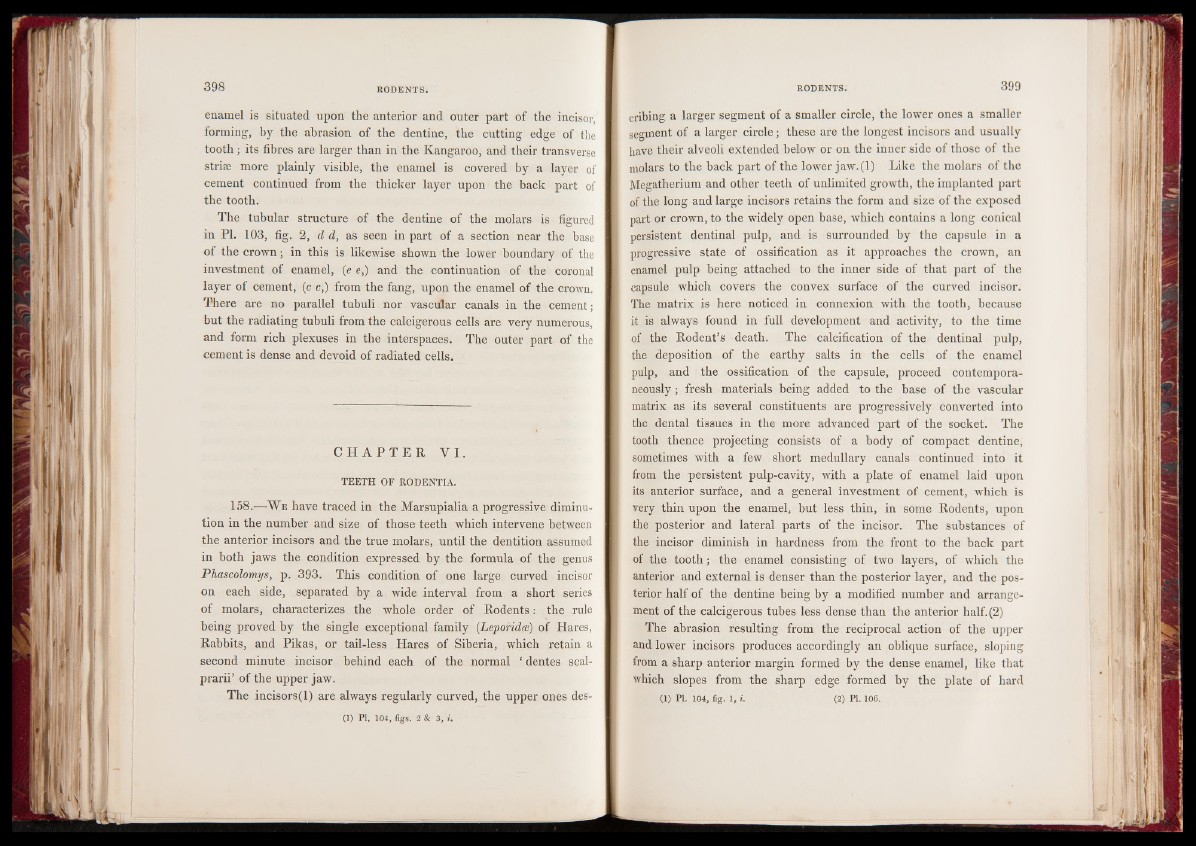
enamel is situated upon the anterior and outer part of the incisor,
forming, by the abrasion of the dentine, the cutting edge of the
tooth; its fibres are larger than in the Kangaroo, and their transverse
strise more plainly visible, the enamel is covered by a layer of
cement continued from the thicker layer upon the back part of
the tooth.
The tubular structure of the dentine of the molars is figured
in PI. 103, fig. 2, d d, as seen in part of a section near the base
of the crown; in this is likewise shown the lower boundary of the
investment of enamel, (e e,) and the continuation of the coronal
layer of cement, (c c,) from the fang, upon the enamel of the crown.
There are no parallel tubuli nor vascular canals in the cement;
but the radiating tubuli from the calcigerous cells are very numerous,
and form rich plexuses in the interspaces. The outer part of the
cement is dense and devoid of radiated cells.
C H A P T E R VI .
TEETH OF RODENTIA.
158.—We have traced in the Marsupialia a progressive diminution
in the number and size of those teeth which intervene between
the anterior incisors and the true molars, until the dentition assumed
in both jaws the condition expressed by the formula of the genus
Phascolomys, p. 393. This condition of one large curved incisor
on each side, separated by a wide interval from a short series
of molars, characterizes the whole order of Rodents: the rule
being proved by the single exceptional family (Leporidce) of Hares,
Rabbits, and Pikas, or tail-less Hares of Siberia, which retain a
second minute incisor behind each of the normal ‘ dentes scal-
prarii’ of the upper jaw.
The incisors(l) are always regularly curved, the upper ones describing
a larger segment of a smaller circle, the lower ones a smaller
segment of a larger circle; these are the longest incisors and usually
have their alveoli extended below or on the inner side of those of the
molars to the back part of the lower jaw.(l) Like the molars of the
Megatherium and other teeth of unlimited growth, the implanted part
of the long and large incisors retains the form and size of the exposed
part or crown, to the widely open base, which contains a long conical
persistent dentinal pulp, and is surrounded by the capsule in a
progressive state of ossification as it approaches the crown, an
enamel pulp being attached to the inner side of that part of the
capsule which covers the convex surface of the curved incisor.
The matrix is here noticed in connexion with the tooth, because
it is always found in full development and activity, to the time
of the Rodent’s death. The calcification of the dentinal pulp,
the deposition of the earthy salts in the cells of the enamel
pulp, and the ossification of the capsule, proceed contemporaneously
; fresh materials being added to the base of the vascular
matrix as its several constituents are progressively converted into
the dental tissues in the more advanced part of the socket. The
tooth thence projecting consists of a body of compact dentine,
sometimes with a few short medullary canals continued into it
from the persistent pulp-cavity, with a plate of enamel laid upon
its anterior surface, and a general investment of cement, which is
very thin upon the enamel, but less thin, in some Rodents, upon
the posterior and lateral parts of the incisor. The substances of
the incisor diminish in hardness from the front to the hack part
of the tooth; the enamel consisting of two layers, of which the
anterior and external is denser than the posterior layer, and the posterior
half of the dentine being by a modified number and arrangement
of the calcigerous tubes less dense than the anterior half. (2)
The abrasion resulting from the reciprocal action of the upper
and lower incisors produces accordingly an oblique surface, sloping
from a sharp anterior margin formed by the dense enamel, like that
which slopes from the sharp edge formed by the plate of hard
(1) PI. 104, fig. 1, i. (2) PI. 106.